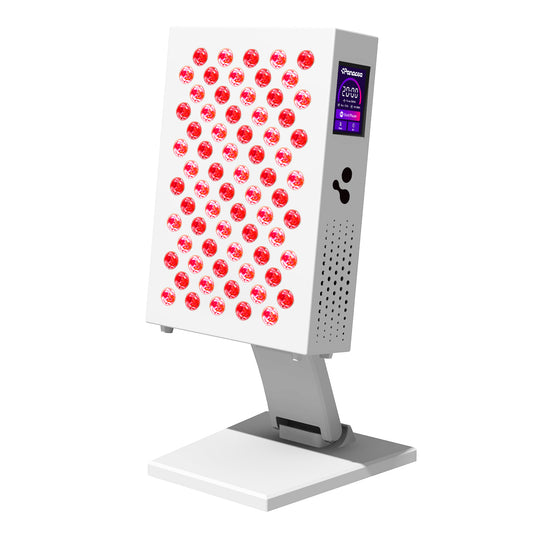
Red light therapy and female hormones
Red Light Therapy and Female Hormones: Natural Support for Cycle, Fertility and Balance
Female hormones are anything but stable – they fluctuate continuously with the cycle, life stage and external influences such as stress, sleep, nutrition and light. If this balance is disturbed, it can manifest as fatigue, mood swings, painful periods, reduced fertility or even hormonal disorders such as PCOS.
More and more women are discovering red light therapy as a natural, non-invasive way to support the hormonal system. But how does it work exactly? And what does science say about red light, the menstrual cycle and even pregnancy?
In this blog, we dive into the relationship between red light therapy and female hormonal health – including concrete research results.
How light affects the hormonal system
The endocrine (hormonal) system responds strongly to light and dark , especially through the hypothalamus and pituitary gland – the two brain regions that control much of the hormonal system. Light affects, among other things:
- The production of melatonin , which indirectly influences the release of estrogen, LH and FSH
- The functioning of the hypothalamic-pituitary-gonadal axis , which regulates the reproductive cycle
- The cortisol balance , which has a direct effect on the sex hormones
Red and near-infrared light (between 630 and 1060 nm) works deeply on cells and tissues via photobiomodulation , activating the mitochondria to produce more energy (ATP). This has a positive effect on energy management, recovery, anti-inflammatory and hormonal regulation , among other things.
Influence on the menstrual cycle
A healthy menstrual cycle depends on a good cooperation between different hormones, including estrogen, progesterone, LH and FSH. Red light therapy can contribute to a balanced cycle in several ways:
- Improving mitochondrial function : Estrogen production is partly dependent on properly functioning mitochondria in the ovaries and adrenal glands.
- Anti-inflammatory : In women with severe menstrual pain or endometriosis, red light can help by locally reducing inflammation.
- Autonomic nervous system regulation : Red light activates the parasympathetic nervous system, which helps with stress regulation and balance between cortisol and sex hormones.
A small 2018 study showed that transdermal application of red light to the lower abdomen led to a shortening of long cycles in women with PCOS .
Source: PubMed – Light therapy for PCOS
In addition, many women experience fewer menstrual complaints , such as cramps or mood swings, when they regularly use red light on the lower abdomen or lower back during the luteal phase (the week before menstruation).
Support during pregnancy
During pregnancy, the female body changes dramatically. Although the use of red light therapy during pregnancy has been studied to a limited extent, there are a number of important insights:
- Red light stimulates cell growth and tissue repair , which can provide support for fatigue, muscle pain or back problems.
- It improves blood flow to the placenta and uterus , which may be beneficial for oxygen supply.
- It has a relaxing effect on the nervous system, which can help with hormonal mood swings and sleep problems.
A 2016 animal study found that red light therapy positively affected placental development and fetal metabolism.
Source: Infrared Light and Pregnancy Outcomes in Rats
Important: During pregnancy we strongly advise against the use of red light therapy on or around the abdomen . Although some studies suggest positive effects, there is still insufficient scientific evidence on the safety for pregnant women and their unborn child.
We therefore do not recommend the targeted use of therapeutic light during pregnancy , unless this is done explicitly in consultation with a doctor or midwife.
If relief is sought (for example for back pain or fatigue), limit the application to indirect and short sessions on, for example, the back, legs or soles of the feet - only after professional medical advice.
Effect on fertility and cycle recovery
For women who have difficulty conceiving, red light therapy can also play an interesting role:
- Improvement of ovarian function and follicle growth via mitochondrial stimulation
- Regulation of the circadian rhythm , which influences LH surges and ovulation
- Support of the endometrium , by improving microcirculation
Japanese research showed that 22% of women with reduced egg quality still became pregnant spontaneously within 6 months after photobiomodulation (at 830 nm).
Source: Low Level Light Therapy in Infertile Women
Red light and hormonal imbalance (PCOS, PMS, burnout)
Many women struggle with hormonal imbalances due to stress, diet, lack of sleep or use of hormonal contraceptives. Symptoms may include:
- Irregular or absent menstrual periods
- Severe PMS symptoms
- Decreased energy and libido
- Anxiety, depression or burnout
Red light therapy can provide natural relief here by:
- Lowering stress hormones such as cortisol
- Normalizing melatonin and serotonin levels
- Stimulating cell renewal in adrenal glands and ovaries
Regular use, especially in the evening (around 8:00–10:00 PM), supports the hormonal day-night rhythm and can have an effect on mood, cycle and energy within a few weeks.
Conclusion
Red light therapy offers a wide range of benefits for women seeking hormonal support – whether it’s regulating the cycle, reducing menstrual discomfort, promoting fertility or supporting pregnancy. The key is consistent application at the right time of the cycle or day.
Please note: red light therapy is not a replacement for medical care. For specific hormonal complaints or pregnancy, consultation with a doctor or therapist is always recommended.
Want to discover which red light lamp best suits your phase or complaint? Visit our webshop or contact us for personal advice.







